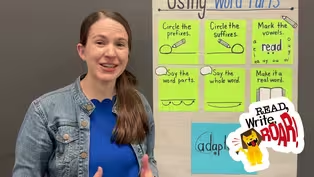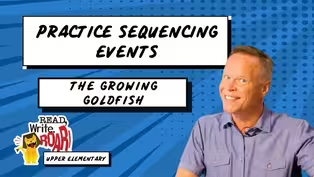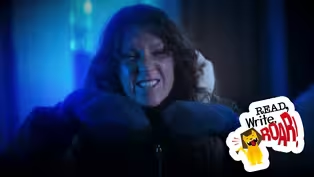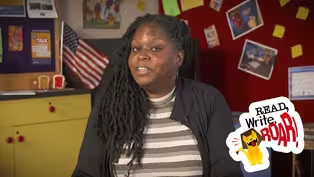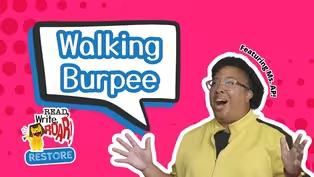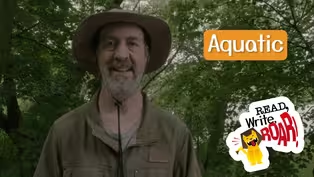Read, Write, ROAR!
What's up with Our Wildlife?
Season 1 Episode 1014 | 26m 45sVideo has Closed Captions
Learn about cause and effect through a fun literacy lesson.
On Read, Write, ROAR! Discover how tiny goldfish can threaten the Great Lakes ecosystem and learn about cause and effect through a fun literacy lesson. Then, explore Detroit’s surprising wildlife and learn how animals like beavers and raccoons thrive in the busy city. Let’s go Read, Write, ROAR!
Problems playing video? | Closed Captioning Feedback
Problems playing video? | Closed Captioning Feedback
Read, Write, ROAR! is a local public television program presented by Detroit PBS
Read, Write, ROAR!
What's up with Our Wildlife?
Season 1 Episode 1014 | 26m 45sVideo has Closed Captions
On Read, Write, ROAR! Discover how tiny goldfish can threaten the Great Lakes ecosystem and learn about cause and effect through a fun literacy lesson. Then, explore Detroit’s surprising wildlife and learn how animals like beavers and raccoons thrive in the busy city. Let’s go Read, Write, ROAR!
Problems playing video? | Closed Captioning Feedback
How to Watch Read, Write, ROAR!
Read, Write, ROAR! is available to stream on pbs.org and the free PBS App, available on iPhone, Apple TV, Android TV, Android smartphones, Amazon Fire TV, Amazon Fire Tablet, Roku, Samsung Smart TV, and Vizio.
Providing Support for PBS.org
Learn Moreabout PBS online sponsorship- On "Read, Write, Roar!"
discover how tiny goldfish can threaten the Great Lakes' ecosystem and learn about the cause and effect through a fun literacy lesson.
Then explore Detroit's surprising wildlife and learn how animals like beavers and raccoons thrive in the busy city.
Let's go read, write, roar.
- [Narrator] This program is made possible in part by the state of Michigan and by and by viewers like you.
Thank you.
(upbeat music) - If I drop an egg, what happens or what is the effect?
It breaks.
What causes the egg to break?
Dropping the egg.
So dropping the egg is the cause and the effect is the egg breaking.
Hi, it's Mr. Peterson, and today, we're going to be reading about goldfish, a common household pet, and how our actions can cause unintentional or accidental effects on life in the Great Lakes.
I found this article from our friends at Great Lakes Now all about the harmful and invasive goldfish.
As I read the article, I'm going to use a cause and effect chart so we can track the information we are learning about goldfish as an invasive species.
This chart will help us organize and better understand what we are learning.
In this column of the chart, we will put a cause, and in this column we're gonna put the effect.
Remember, a cause is why something, the effect, happens.
You can make your own cause and effect chart.
You just need any piece of paper.
Draw two rectangles next to each other with an arrow pointing from one to the other.
Label the one on the left the cause, and the one on the right effect.
As we read, I'm going to look out for words that might be clues for cause and effect structure and relationships.
Those are words like because, then, as a result, and since.
Okay, let's get started.
A tiny goldfish might look cute in a fishbowl on your shelf, but if released into the wild, it can grow to a terrifying size and become a menace to the ecosystem.
They eat pretty much anything and everything, root up plants causing the water to become cloudy and dark, and reproduce and grow so quickly that almost no predators can stop them.
I think I see a clue word in here.
The word causing is a key word that can help us identify the cause or the reason why something happened.
In this case, the goldfish uprooting or pulling up plant roots causes the water to become cloudy and dark.
Okay, the cause is the goldfish uproot plants, which then gives the effect of the water becoming cloudy and dark.
Okay, let's keep reading.
Feral goldfish have been invading much of North America, including the Great Lakes, for decades and recently their numbers seem to be rising rapidly.
The reason for the uptick is not clear, but it could be because invasive carp are being better controlled, and the goldfish are taking their place.
Let's take a look at this sentence.
Here's another one of those clue words, because.
The invasive carp are being better controlled, that's the cause.
The goldfish are taking their place, and that's the effect.
Let's keep going.
While goldfish may seem small and vulnerable, they are actually very good invaders.
They are hardy and adaptable, able to survive and thrive under a wide range of temperature and oxygen conditions that many native species can't handle.
Biologists must fight any perception that goldfish are harmless species when released into the wild.
Tossing an unwanted pet into the pond or flushing it down the toilet can have serious consequences for our lakes and wetlands.
What is our cause and effect here?
Do we have any clue words?
I don't see any of our specific clue words, but let's take a look at this last sentence.
Tossing an unwanted pet into a pond or flushing it down the toilet can have serious consequences for our lakes and wetlands.
In this sentence, the word consequences is a clue word.
Consequence means a result or effect of an action.
So the cause, tossing an unwanted pet into a pond or flushing it down the toilet.
The effect, consequences for our lakes and wetlands.
I think we can be more specific for our effect.
What are some of the consequences or the results of releasing an unwanted goldfish into a pond?
Let's look back at the beginning of our article.
They eat pretty much anything and everything, root up plants causing the water to become cloudy and dark, and reproduce and grow so quickly that almost no predators can stop them.
So for effect, I'm going to put goldfish impact our lakes and wetlands by causing cloudy and dark waters, eating everything, and having no predators.
How can you help keep our Great Lakes' ecosystem in balance?
First and foremost, never release a goldfish or any animal that does not naturally belong into the ecosystem.
If you no longer can care for your goldfish, you can see if a pet store will take it back.
You could also gift it to a friend or an education center.
Knowing the cause or why something happens often helps us better understand effects.
What effects are caused by your actions?
What can you do or not do to help protect our Great Lakes?
(upbeat music) - Ms. AP here to help restore your energy.
Before we begin, let's start with our warmup by doing two forward folds.
Standing your tall mountain, arms up, folding over, feeling that stretch, rolling up, one last time.
Arms up, folding over, feeling that stretch, rolling back into your tall mountain.
Nice job.
Now that we have warmed up our body, we are ready to exercise.
Today, we are gonna learn the basic movements of a burpee.
To do a burpee, we'll start in the ready position with our feet apart, hands at our sides, and we are gonna squat down into our imaginary chair until we bend and land our hands on the floor.
We're gonna stretch our legs out almost like in that plank position and walk our legs forward.
Standing back up into our ready position.
Coming back down into our squat, hands down on the floor, walking your feet out, walking your feet up, and standing back in your ready position.
One last time, coming down into your squat, hands down on the floor, walking your feet back, walking your feet up.
Coming back into your ready position.
Give yourselves a big clap clap.
(Ms. AP claps) Nice job.
Let's cool down by taking two deep breaths.
Deep breath in, deep breath out.
Deep breaths in, deep breath out.
Great job.
(upbeat music) - Hi, I'm naturalist Paul Roose.
Have you ever thought about how your actions affect plants and animals?
Today, we are going to go outside and explore different spots along the Cass River Trail here in mid-Michigan.
We will discover how people can change the environment in both positive and negative ways.
We'll also practice reading and nature journaling outdoors while learning to protect Michigan's natural river resources.
So grab something to write with and a piece of paper or your nature journal and let's go out and explore.
Check out this trail sign here at the boat launch here in Frankenmuth, Michigan.
Let's read and write these words together.
Invasive species.
What is an invasive species?
An invasive species is any organism or living thing that is introduced to an area outside of its native area where it's normally found.
They can negatively impact our environment, the economy, or even our health.
People don't often realize it, but they often move invasive species from place to place on both land and water.
The invasive species often hitches a ride with humans ranging from boats to boots.
Other examples of invasives include moving firewood full of insects from your home to a campground or bringing home a beautiful flowering plant from another state and planting it in your yard.
In Michigan where we have so much fresh water habitat found in our lakes, rivers, and ponds, aquatic invasive species found in the water represent a quiet yet harmful form of water pollution.
Aquatic invasive species can hitch a ride to a new area on a boat that empties water from one river to another.
Often, boats carry eggs, seeds, or little animals with them.
These invasives multiply and grow.
They can quickly eat up and take over a new area.
They force out the native plants and animals, damaging our water resources.
What are some invasive species found along the Cass River?
Let's read our trail signs to learn more and how to recognize some of them.
Here's a picture of European frog-bit, flowering rush, and Phragmites.
Now that we have read some information, let's use our nature detective skills and see if we can spot anything near the river.
Let's write down any invasive species we find in our nature journal.
Look, these leaves look just like what I saw in red on the sign.
It appears that flowering rush is just starting to grow.
Now we're at another spot along the Cass River Trail at Bridgeport Township Park where we are going to learn about how we can help stop the spread of invasive species.
Let's read this trail sign.
Are your shoes clean?
You could be spreading invasive species on the trail.
How to prevent the spread of harmful plants.
Arrive with clean gear.
Clean your shoes, clothes, packs, and pets before exploring.
Stay on marked trails to reduce the chances of picking up seeds and mud that carry invasive species.
Leave with clean gear.
Clean your shoes, clothes, packs, and pets after exploring.
Now, I'm going to clean my boots using the boot brush, which helps prevent the spread of invasives before I go boating or hiking on the trails.
Notice at this cleaning station, there are tools to help remove mud, plants, and debris.
Reading trail signs that really helps us understand invasive species and how we can prevent the spread.
You can learn more about aquatic environments and invasive species in your area by doing an internet research with your guardian or teacher, including key terms such as your town's name, the name of your local waterways, and invasive species.
When you are exploring Michigan's outdoors by land or water, remember that reading and following trail signs is an important way that you can help protect Michigan's natural resources.
(upbeat music) - You probably already know Detroit as the home of Motown, cars, and square pizza.
But did you know that Detroit is also home to a wide variety of wildlife?
Hi everyone.
I'm Ms. Rogers.
Despite being a bustling city, a surprising number of wild animals call Detroit home.
From beavers and muskrats to skunks, pheasants, and coyotes, these animals survive and even thrive or do well in a busy city environment.
But why do they choose to live there?
To get to the bottom of this, I found an article that talks about wildlife in Detroit.
The article by Koby Levin is written in the second person and explains the perspective of one woman that lives in Detroit.
When we are finished reading the article, I'll show you how to use a tool that will help us organize and connect new ideas and vocabulary so we can better understand what we read.
In Detroit's early days, the land around Raquel Garcia's southwest Detroit home was mostly forest, but that only partly explains why there are a dozen baby raccoons in her dining room.
Garcia is a professional environmental activist who also puts in long hours as a volunteer wildlife rehabilitator with a focus on raccoons.
Raccoons in a chimney?
She gets a call.
Orphan baby raccoon in a backyard?
She'll bring it home to the cages in her house where she'll feed it until it grows enough to survive on its own.
Every time she brings in an animal, she believes she is saving its life.
Let's pause our reading for a moment.
We read a word that you may not be familiar with, rehabilitator.
Sometimes when you come across a new word, you can use base words, root words, prefixes, and suffixes to help you read it.
I've heard of a rehab, which is where my grandmother went after surgery on her hip so she could get better to walk again.
Rehab as in rehabilitator, so I think maybe this has something to do with the way of getting better when injured.
I know that, and now I can look at the surrounding words or sentences to help me figure out the meaning, which is called using context clues.
So what clues does this paragraph give us about what the word rehabilitator could mean?
She'll bring it home to the cages in her house until it grows enough to survive on its own.
This sentence shows that Garcia helps raccoons get better.
So using my own knowledge and the context clues, I think a rehabilitator is someone who helps animals get better so they can live on their own again.
Why wildlife thrives in Detroit.
Cities are rough places for wild animals, which can "get hit by cars" and "attacked by dogs," said Cindi Russ, founder of Ferndale-based Motor City Possum Rescue.
"In the fall, I get a lot of juvenile possums with rat trap injuries."
Still, some animals find ways to thrive in Detroit, thanks in part to our low population density in large parks.
Beavers, muskrats, cottontail rabbits, skunks, possums, groundhogs, foxes, coyotes and more make themselves home in Detroit.
Favorable conditions for wildlife can lead to conflict with humans.
Just this month, the city held a meeting about goose and deer populations exploding in Rouge and Chandler Parks and spreading to surrounding neighborhoods.
"The ecosystem in those parks has gone unbalanced," said Jessica Parker, Deputy Chief Operating Officer for City of Detroit.
Excessive goose populations can cause water quality issues at beaches, while deer have caused a growing number of car crashes in metro Detroit.
Remember the helpful tool I mentioned earlier?
Well, it's called a semantic map and it's used to help us to organize, connect, remember, and better understand new ideas and vocabulary.
Here's how semantic mapping works.
The main topic goes in the middle and each branch connects to a related vocabulary word or idea.
Let's make a semantic map to summarize what we've learned about wildlife in Detroit.
At the center of our map, we'll write wildlife in Detroit, since that's our main topic.
Now let's create branches to explore different aspects of wildlife in Detroit.
Let's start with types of wildlife.
I remember the article sharing some of the types of wildlife animals that are found in Detroit.
So add them under this branch.
Possum, muskrats, beavers, cottontail rabbits.
Now let's think about why these animals might thrive in Detroit.
So now let's add another branch called favorable conditions.
Do you remember what makes Detroit an inviting place for wildlife?
That's right, low population density or lots of open land with fewer people was the reason.
Large parks and adaptable animal species.
But as you can imagine, having all these animals around can sometimes lead to problems.
So let's add another branch for conflicts with humans.
I'm going to add water quality issues, deer in neighborhoods, more car crashes.
By creating this semantic map, we've organized our information into subtopics around a topic.
It helps us to see not only what kinds of wildlife live in Detroit, but also why they're able to thrive and what challenges they create for humans too.
Organizing information like this can make even the most difficult topics easier to understand.
Next time you're out and about, take a moment to observe the wildlife around you.
What do you see that you can connect to the map we've made?
You might even use what you see to start your own map.
Happy observing.
(upbeat music) - Hello, friends.
I'm Ms. Audra, and today we're gonna go to the tundra.
So I want you to start thinking about all the sounds you might hear as we take our deep breath in together.
Let's do it, here we go.
And I'm gonna blow it out like ice.
(Ms. Audra imitates ice whooshing) Breathe in deep.
Hold, blow it out any way you want.
I'm doing ice.
(Ms. Audra imitates ice whooshing) Nice.
So think about all the sounds you might hear in the ice world.
Maybe there's an avalanche and ice is falling into the ocean.
Maybe there's a polar bear growling or little cubs are walking along.
Maybe there's a little ice fox jumping into the snow.
So think about the sounds you're gonna make.
Maybe it's just the wind rushing across that beautiful, beautiful ice land.
All right, on the count of three, don't forget to use your hands, your arm, or your whole body if you can.
On the count of three, one, two, three.
(gentle music) And I'm gonna make my sound.
(Ms. Audra imitates footsteps patting) And on the count of three, one, two, three, and pause.
Nice job.
Think about all the beautiful sounds that we made, the cacophony of sounds that we created to represent the ice world of the tundra.
Thank you for joining, and let's take that deep breath in before we go, here we go.
And I'm gonna blow it out like my little creature walking across the ice.
(Ms. Audra imitates footsteps patting) Nice, see you next time.
(upbeat music) - Do you ever find complicated words when you're reading?
I know I do.
I'm Mrs. Mora.
Today we'll learn to use word parts to read and understand unknown words.
Recently while reading about urban wildlife, I found some difficult words.
Here's one.
First, let's circle the prefixes.
A prefix is a word part added to the beginning of a word to change its meaning.
Do you see a prefix?
It's A-D. Next, let's circle the suffixes.
A suffix is a word part added to the end of a word to change its meaning.
Do you see a suffix?
The suffix A-B-L-E is pronounced able.
Able often means able to.
Next, let's mark the remaining vowels.
Vowels help us break words into syllables.
Every syllable has at least one vowel and only one vowel sound.
Which vowels do you see?
We see the letter A.
Since there is one vowel, we expect to find one syllable in this root.
Now, let's say the whole word.
Adaptable.
Is that a word?
Not quite.
Let's try different sounds to make this a real word.
I know the letter A often makes the schwa sound uh at the beginning of a word.
Adaptable.
Adaptable.
Adapt means to change for a certain use or purpose.
So adaptable means to be able to change for a certain use or purpose.
Many adaptable forest animals have learned to live in cities.
We often call these animals urban wildlife.
If you speak Spanish, the word (speaks in foreign language) can help you understand this word.
Here's another word.
First, let's circle the prefixes.
Do you see any prefixes?
There aren't any.
Next, let's circle the suffixes.
What do you see?
I know the suffix able.
Now let's mark the remaining vowels.
We see an A.
We also see O with R, which is an R-controlled vowel.
Since there are two vowels, we expect to find two syllables in this part.
Let's split these syllables between the A and the V. Let's say the word parts.
Favorable.
Now, let's say the whole word.
Favorable.
Is that a word?
It is.
Since this is a word, we're finished.
Favorable describes something that gives you an advantage or helps you be successful.
Many clever wild animals enjoyed the favorable conditions in my garden this summer.
They ate most of my vegetables.
If you speak Spanish, the word (speaks in foreign language) can help you understand this word.
Great work today.
Keep reading and try this strategy the next time you find a challenging word.
- [Narrator] This program is made possible in part by the state of Michigan and by and by viewers like you.
Thank you.
(upbeat music)
Adaptable & Favorable: Decoding Multisyllabic Words | Mrs. Mora | Read, Write, ROAR!
Video has Closed Captions
Clip: S1 Ep1014 | 4m 17s | What do "adaptable" and "favorable" have in common? (4m 17s)
Aquatic Intruders: Goldfish Effects | Cause and Effect for Grades 4-5
Video has Closed Captions
Clip: S1 Ep1014 | 6m 38s | Create a cause and effect chart to enhance your reading and writing skills! (6m 38s)
Create a Tundra Soundscape | Ms. Audra | Read, Write, ROAR!
Video has Closed Captions
Clip: S1 Ep1014 | 2m 15s | Imagine the sounds of avalanches, polar bears, and the icy wind as we create a winter wonderland. (2m 15s)
Explore Wildlife in Detroit | Ms. Rodgers | Read, Write, ROAR!
Video has Closed Captions
Clip: S1 Ep1014 | 7m 17s | Explore the surprising wildlife of Detroit with Ms. Rodgers. (7m 17s)
Read, Write, ROAR! Restore - Walking Burpee
Video has Closed Captions
Clip: S1 Ep1014 | 2m 26s | Learn the fundamentals of burpees with Ms. AP in this 2-minute movement snack. (2m 26s)
Writing About Aquatic Invasive Species | Paul Roose | Read, Write, ROAR!
Video has Closed Captions
Clip: S1 Ep1014 | 4m 40s | Learn how to identify and prevent the spread of aquatic invaders to protect the environment. (4m 40s)
Providing Support for PBS.org
Learn Moreabout PBS online sponsorshipSupport for PBS provided by:
Read, Write, ROAR! is a local public television program presented by Detroit PBS
